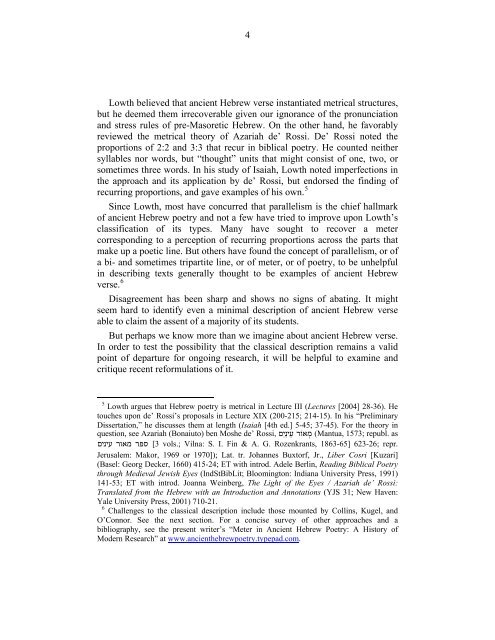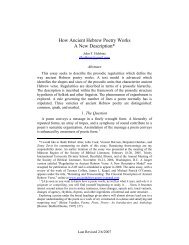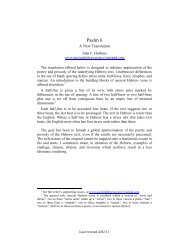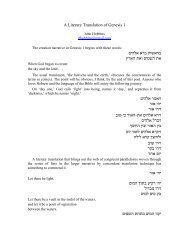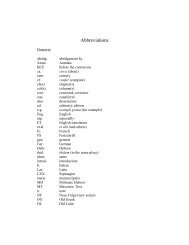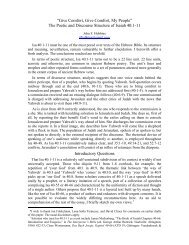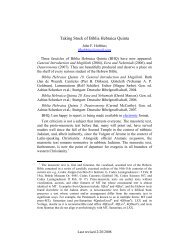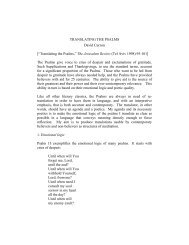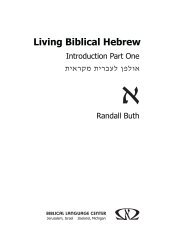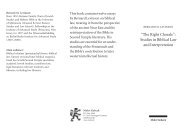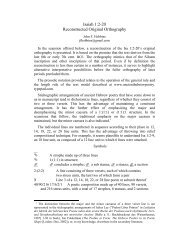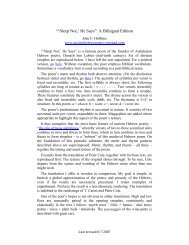Here - Ancient Hebrew Poetry - Typepad
Here - Ancient Hebrew Poetry - Typepad
Here - Ancient Hebrew Poetry - Typepad
- No tags were found...
You also want an ePaper? Increase the reach of your titles
YUMPU automatically turns print PDFs into web optimized ePapers that Google loves.
4Lowth believed that ancient <strong>Hebrew</strong> verse instantiated metrical structures,but he deemed them irrecoverable given our ignorance of the pronunciationand stress rules of pre-Masoretic <strong>Hebrew</strong>. On the other hand, he favorablyreviewed the metrical theory of Azariah de’ Rossi. De’ Rossi noted theproportions of 2:2 and 3:3 that recur in biblical poetry. He counted neithersyllables nor words, but “thought” units that might consist of one, two, orsometimes three words. In his study of Isaiah, Lowth noted imperfections inthe approach and its application by de’ Rossi, but endorsed the finding ofrecurring proportions, and gave examples of his own. 5Since Lowth, most have concurred that parallelism is the chief hallmarkof ancient <strong>Hebrew</strong> poetry and not a few have tried to improve upon Lowth’sclassification of its types. Many have sought to recover a metercorresponding to a perception of recurring proportions across the parts thatmake up a poetic line. But others have found the concept of parallelism, or ofa bi- and sometimes tripartite line, or of meter, or of poetry, to be unhelpfulin describing texts generally thought to be examples of ancient <strong>Hebrew</strong>verse. 6Disagreement has been sharp and shows no signs of abating. It mightseem hard to identify even a minimal description of ancient <strong>Hebrew</strong> verseable to claim the assent of a majority of its students.But perhaps we know more than we imagine about ancient <strong>Hebrew</strong> verse.In order to test the possibility that the classical description remains a validpoint of departure for ongoing research, it will be helpful to examine andcritique recent reformulations of it.5 Lowth argues that <strong>Hebrew</strong> poetry is metrical in Lecture III (Lectures [2004] 28-36). Hetouches upon de’ Rossi’s proposals in Lecture XIX (200-215; 214-15). In his “PreliminaryDissertation,” he discusses them at length (Isaiah [4th ed.] 5-45; 37-45). For the theory inquestion, see Azariah (Bonaiuto) ben Moshe de’ Rossi, מְ אוֹר עֵ ינַ יִם (Mantua, 1573; republ. asrepr. [3 vols.; Vilna: S. I. Fin & A. G. Rozenkrants, 1863-65] 623-26; ספר מאור עיניםJerusalem: Makor, 1969 or 1970]); Lat. tr. Johannes Buxtorf, Jr., Liber Cosri [Kuzari](Basel: Georg Decker, 1660) 415-24; ET with introd. Adele Berlin, Reading Biblical <strong>Poetry</strong>through Medieval Jewish Eyes (IndStBibLit; Bloomington: Indiana University Press, 1991)141-53; ET with introd. Joanna Weinberg, The Light of the Eyes / Azariah de’ Rossi:Translated from the <strong>Hebrew</strong> with an Introduction and Annotations (YJS 31; New Haven:Yale University Press, 2001) 710-21.6 Challenges to the classical description include those mounted by Collins, Kugel, andO’Connor. See the next section. For a concise survey of other approaches and abibliography, see the present writer’s “Meter in <strong>Ancient</strong> <strong>Hebrew</strong> <strong>Poetry</strong>: A History ofModern Research” at www.ancienthebrewpoetry.typepad.com.


